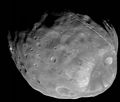Fil:Phobos colour 2008.jpg

Størrelse af denne forhåndsvisning: 636 × 600 pixels. Andre opløsninger: 255 × 240 pixels | 509 × 480 pixels | 815 × 768 pixels | 1.086 × 1.024 pixels | 2.172 × 2.048 pixels | 3.500 × 3.300 pixels.
Fuld opløsning (3.500 × 3.300 billedpunkter, filstørrelse: 2,72 MB, MIME-type: image/jpeg)
Filhistorik
Klik på en dato/tid for at se filen som den så ud på det tidspunkt.
| Dato/tid | Miniaturebillede | Dimensioner | Bruger | Kommentar | |
|---|---|---|---|---|---|
| nuværende | 2. apr. 2018, 05:10 |  | 3.500 × 3.300 (2,72 MB) | Kaldari | more margin on right side |
| 13. nov. 2008, 06:47 |  | 3.374 × 3.300 (2,7 MB) | Fir0002 | == Summary == {{Information |Description=Colour image of Phobos, imaged by the Mars Reconnaisance Orbiter in 2008 |Source=NASA |Date=9 April 2008 |Location=http://www.nasa.gov/mission_pages/MRO/multimedia/pia10368.html |Author=NASA/J |
Filanvendelse
Der er ingen sider der bruger denne fil.
Global filanvendelse
Følgende andre wikier anvender denne fil:
- Anvendelser på af.wikipedia.org
- Anvendelser på an.wikipedia.org
- Anvendelser på ar.wikipedia.org
- المريخ
- فوبوس
- قمرا المريخ
- ويكيبيديا:صور مختارة/الفضاء والكون/نظرة إلى الأعلى
- قائمة أجرام المجموعة الشمسية مرتبة حسب الحجم
- بوابة:علم الفلك/صورة مختارة
- بوابة:المريخ/مقالة مختارة/أرشيف
- بوابة:المريخ/مقالة مختارة/2
- قائمة الأقمار الطبيعية
- خط زمني لاكتشاف كواكب المجموعة الشمسية وأقمارها
- ويكيبيديا:ترشيحات الصور المختارة/القمر فوبوس
- ويكيبيديا:صورة اليوم المختارة/أغسطس 2019
- قالب:صورة اليوم المختارة/2019-08-03
- بوابة:علم الفلك/صورة مختارة/73
- معسكر قاعدة المريخ
- استكشاف الأقمار المريخية
- ويكيبيديا:صورة اليوم المختارة/يناير 2022
- قالب:صورة اليوم المختارة/2022-01-04
- Anvendelser på ary.wikipedia.org
- Anvendelser på arz.wikipedia.org
- Anvendelser på as.wikipedia.org
- Anvendelser på azb.wikipedia.org
- Anvendelser på az.wikipedia.org
- Anvendelser på be-tarask.wikipedia.org
- Anvendelser på be.wikipedia.org
- Anvendelser på bg.wikipedia.org
- Anvendelser på bh.wikipedia.org
- Anvendelser på bn.wikipedia.org
- Anvendelser på bn.wikibooks.org
- Anvendelser på bs.wikipedia.org
Vis flere globale anvendelser af denne fil.





